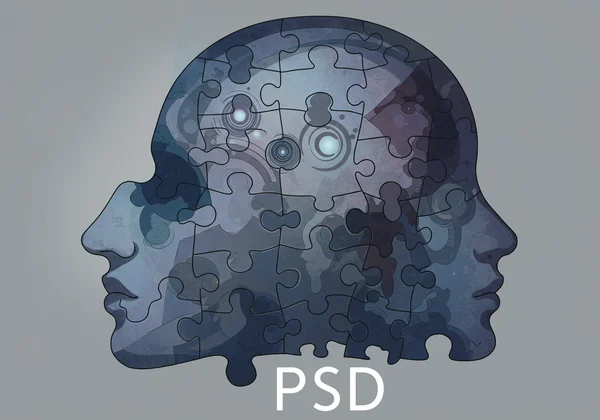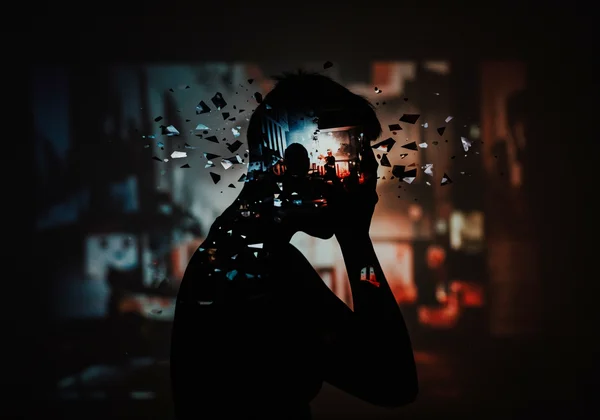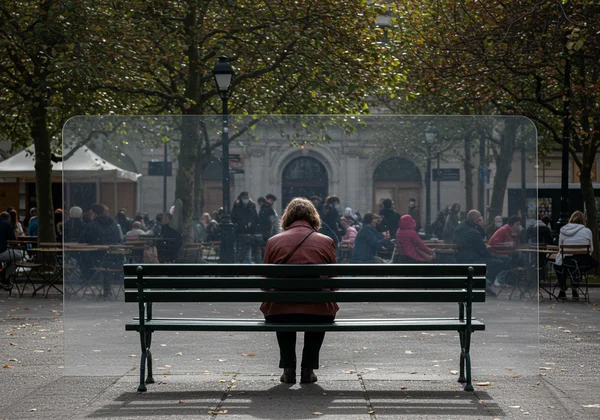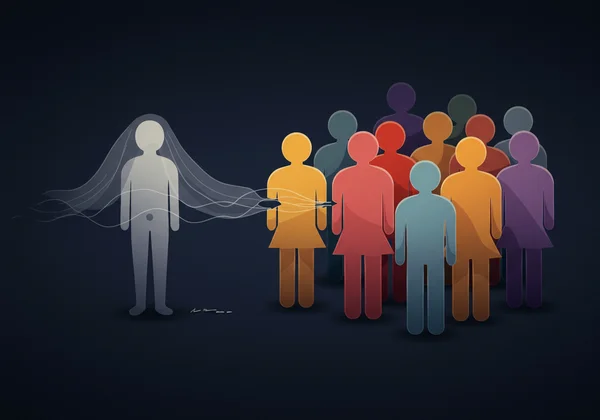PCL5 PTSD 症状详解:DSM-5 症状群指南
许多人想到创伤后应激障碍 (PTSD) 时,脑海中浮现的往往是电影里戏剧化的闪回。虽然重现创伤是关键组成部分,但这只是一个更大、更复杂拼图中的一小块。PTSD 症状 的真实情况更为细致,它以微妙但极具破坏性的方式影响着思想、情感和行为。那么,专业人士会关注的 20 种 PTSD 症状 是什么呢?

本指南旨在带您了解美国精神病学协会 DSM-5(精神健康诊断的金标准)所定义的 PTSD 四种不同症状群。理解这些症状群可以为您的经历提供清晰的认识和验证。这是理解您正在经历的并找到前进之路的第一步。如需一种保密的方式来了解您的自身经历与这些症状的匹配程度,您可以 参加我们的免费 PCL5 测试。
理解 PTSD 症状:DSM-5 的四种症状群
PTSD 不是单一的感觉,而是一系列分为四类的症状。一个人必须经历这四个症状群中的症状才能符合潜在诊断的标准。PCL-5(DSM-5 创伤后应激障碍检查表)的结构直接衡量这四个领域,清晰地反映了潜在的 创伤症状。
B 组:侵扰性症状(PCL-5 问题 1-5)
侵扰性症状或许是最广为人知的。它们涉及创伤事件持续且非自愿地侵入您的当前生活。感觉就像是过去无法真正过去。
反复出现、非自愿且侵入性的痛苦记忆
这不仅仅是回忆起曾发生过不好的事情。这些是 不受控制地涌现 的记忆,会突然出现,带来与原始事件相同程度的强度和痛苦。
反复出现的痛苦梦境
创伤会渗透到您的睡眠中,导致噩梦,在梦中您会重温事件,或体验事件中的主题和情绪。这些梦境会让您感到精疲力竭,害怕入睡。
分离反应(例如,闪回)
闪回是对创伤事件的强烈而生动的重现。它可以是从短暂的、侵入性的图像到完全失去对周围环境的意识,让您仿佛身临其境。

暴露于创伤线索时的强烈或持久的心理痛苦
线索或“触发因素”是创伤的提醒。它们可以是内在的(想法或感受)或外在的(人、地点、声音或气味)。遇到触发因素会引起压倒性的情感痛苦,例如强烈的恐惧、惊恐或愤怒。
对创伤线索的显著生理反应
您的身体也会对触发因素做出强烈反应。当被提醒事件时,这可能表现为心跳加速、出汗、呼吸急促或肌肉紧张。这是您身体警报系统被激活了。
A 组:回避性症状(PCL-5 问题 6-7)
创伤发生后,人们自然会想回避那些让人想起事件的线索。然而,当这种回避成为一种主要的应对策略时,它会严重限制您的生活并阻碍康复。此症状群涵盖了那些试图推开与创伤相关的一切的努力。
回避痛苦的记忆、想法或感受,或为回避这些而付出努力
这是内在的回避。您可能会发现自己试图压抑记忆、推开困难的想法或麻木与创伤相关的情感。这种持续的努力会极大地消耗人的心力与精力。
回避或试图回避外部提醒物
这包括刻意避开可能触发痛苦记忆或感受的人、地点、谈话、活动或情境。虽然这可能提供暂时的缓解,但可能导致社交孤立和世界缩小。如果您发现自己正陷入这些模式,我们的 PCL5 评估 可以为您提供理解的起点。

创伤后的认知和情绪的负面改变
创伤会从根本上改变你看待自己、他人以及世界的方式。此症状群是 DSM-5 PTSD 的关键组成部分,涵盖了您思想和感受中持续的负面转变,这些转变使您难以与他人建立联系或体验到积极情绪。
C 组:负面认知和情绪症状(PCL-5 问题 8-14)
这些症状通常是内在的,他人可能难以察觉,但它们对您的日常生活和自我认知感产生强大的影响。
无法记住创伤事件的重要方面
这不是普通的健忘。这通常是一种保护性的分离性遗忘,您的思想会屏蔽创伤经历的关键细节。
持续且夸大的负面信念或预期
创伤会粉碎您的安全感,导致诸如“我很糟糕”、“没有人可以信任”或“世界完全是危险的”之类的信念。这些信念会影响您对现实的整个看法。
对创伤原因或后果的持续扭曲认知
这通常涉及扭曲地将事件归咎于自己或他人。您可能会背负巨大的内疚感或羞耻感,认为自己本可以做得不同,即使那已超出您的控制。
持续的负面情绪状态
此症状描述了持续存在的负面情绪,如恐惧、惊恐、愤怒、内疚或羞耻。您可能会觉得这些情绪已成为您的新常态。
对重要活动的兴趣或参与度明显下降
您曾经喜欢的活动现在可能显得毫无意义,或者需要花费过多的精力。这种失去兴趣的现象称为快感缺失,可能导致您退出爱好、热情和社交活动。
感到与他人疏远或格格不入
您可能会感觉自己像个旁观者,与您所爱的人脱节。这种情感麻木会使建立或维持亲密关系变得困难,造成深刻的孤独感。

持续无法体验积极情绪
就像负面情绪会变得持续一样,体验积极情绪——如快乐、爱或喜悦——的能力也可能被阻碍。感觉就像一层窗帘遮蔽了生活中更光明的方面。理解这些复杂的改变至关重要,PCL 5 问卷 可以帮助您梳理清楚。
唤醒与反应的改变:战斗或逃跑反应
PTSD 四个症状群 中的最后一个与创伤如何让您的身体警报系统一直处于高度戒备状态有关。您的战斗或逃跑反应很容易被触发,让您感到紧张、焦虑和易怒。
D 组:唤醒与反应的改变症状(PCL-5 问题 15-20)
这些症状反映了身心持续扫描危险,无法放松进入安全状态。
易怒行为和愤怒爆发
当您的神经系统处于高度戒备状态时,您的耐心会变得很差。这可能导致易怒和愤怒的爆发,这些爆发似乎毫无征兆地出现,通常是轻微或完全没有诱因的。
鲁莽或自毁行为
这可以是一种感受非麻木感的方式,或是在潜意识中试图处理创伤相关的危险,从而重现创伤。这可能包括药物滥用、鲁莽驾驶或不安全的性行为等行为。
高度警觉
高度警觉就像一个时刻待命的保安。您会不断扫描周围环境中的威胁,使您无法放松。这可能令人筋疲力尽。

过度的惊吓反应
您的惊吓反射会变得更加敏感。一个意外的声音,例如门砰地关上或汽车放炮,可能会让您剧烈跳动或触发强烈的恐惧反应。
注意力不集中
当您的思想持续处于对危险的警觉状态时,您会难以集中注意力处理任务、跟上谈话或记住事情。这会影响您在工作、学习和日常生活中的表现。
睡眠障碍
这包括入睡困难、睡眠维持困难或睡眠不安且无法恢复。再加上痛苦的梦境,睡眠问题会严重影响您的精力和整体健康。
识别症状并迈出下一步
阅读这份列表可能会让人感到不知所措,但知识就是力量。在这些描述中认识到您自己的经历是勇敢且至关重要的一步。这些症状不是软弱的表现;它们是对压倒性事件的可以理解的反应。
PCL-5 检查表旨在帮助个人和专业人士系统地回顾这些症状。它提供了一种结构化的方式来反思您过去一个月的经历。您的清晰和理解之旅可以从现在开始。通过参加一项保密的 在线 PTSD 测试 来了解您目前的情况。
关于 PTSD 症状和 PCL5 的常见问题
DSM-5 中概述的 20 种 PTSD 症状是什么?
20 种症状分为四类:侵扰性(5 种症状,如闪回和噩梦)、回避性(2 种症状)、认知和情绪的负面改变(7 种症状,如责备和疏离)以及唤醒和反应的改变(6 种症状,如高度警觉和睡眠问题),所有这些都在上面的文章中详细介绍。
PCL5 检查表如何衡量这些 PTSD 症状?
PCL-5 以问题的形式呈现这 20 种症状。您在过去一个月中,每种症状困扰您的程度进行 5 点评分,从“一点也没有”到“极其严重”。这将产生一个分数,有助于量化您症状的严重程度,并提供一个清晰的概述,供您进行自我反思或与专业人士分享。
我可以使用 PCL5 测试来自我诊断 PTSD 吗?
不可以。PCL-5 是一个高度可靠的筛查和评估工具,但它不是诊断工具。只有合格的心理健康专业人士在进行全面评估后才能提供正式的 PTSD 诊断。我们的工具旨在为您提供宝贵的个人见解,并作为与专业人士对话的起点。
PCL5 测试适合所有年龄段吗?
标准的 PCL-5 是为成年人(18 岁及以上)设计和验证的。有不同的评估方法用于经历过创伤的儿童和青少年。PCL5.com 上的测试仅供成人使用。